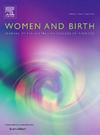Intrapartum and childbirth care and outcomes in midwife-led birth centres in France: A nationwide descriptive study with an analysis of maternal and neonatal transfers
IF 4.4
2区 医学
Q1 NURSING
引用次数: 0
Abstract
Problem
Midwife-led birth centres (MLBCs) offer an alternative to obstetric-led units (OUs) for low-risk women. Despite positive assessments, their development still remains controversial.
Aim
To assess the appropriateness of care, intrapartum and childbirth care, and outcomes of women with a planned birth in MLBCs and to describe transfers to OUs and their risk factors.
Methods
This was a 2-year (2018–2019) nationwide population-based retrospective cohort involving women with a planned birth in all eight French MLBCs. We described the appropriateness of care, intrapartum and childbirth care, maternal and neonatal outcomes and causes of transfers to OUs. We calculated adjusted odds ratios to identify risk factors for transfers during labour and after birth.
Results
Among 1313 women with a planned MLBC birth, the appropriateness of care was high, with 99.3 % of women meeting low-risk criteria. Intrapartum care in MLBCs featured few interventions (2.2 % artificial membrane ruptures and 1.1 % episiotomies). Regardless of the final place of birth, there were 90.8 % spontaneous vaginal births, 2.6 % caesarean births, 6.6 % operative vaginal births, 2.4 % severe postpartum haemorrhages, 0.4 % Apgar scores < 7 at 5 min and one neonatal death. Transfers to an OU involved 21 % of women with a planned birth in an MLBC during labour and 5.8 % after birth, mainly due to postpartum haemorrhage; 4.6 % of newborns were transferred, often for monitoring.
Conclusion
With appropriate selection of women and low-intervention care, French MLBCs achieve salutogenic outcomes. We identified risk factors for transfers. Further research is needed to assess safety comprehensively with comparative studies.
法国助产士主导的分娩中心的产时和分娩护理和结果:一项全国性的描述性研究,分析了孕产妇和新生儿转移
问题助产士领导的生育中心(mlbc)为低风险妇女提供产科领导的单位(ou)的另一种选择。尽管有积极的评价,但它们的发展仍然存在争议。目的评估mlbc中计划生育妇女的护理、产时和分娩护理的适当性和结局,并描述转移到ou及其危险因素。方法:这是一项为期2年(2018-2019)的全国性人群回顾性队列研究,涉及法国所有8个mlbc的计划生育妇女。我们描述了护理的适当性、产时和分娩护理、孕产妇和新生儿结局以及转移到ou的原因。我们计算了调整后的优势比,以确定分娩期间和出生后转移的危险因素。结果在1313例计划MLBC分娩的妇女中,护理的适宜性高,99.3% %的妇女符合低风险标准。mlbc的产时护理很少有干预措施(2.2% %人工膜破裂和1.1% %外阴切开术)。无论最终出生地点如何,90.8 %阴道自然分娩,2.6 %剖腹产,6.6 %阴道手术分娩,2.4 %产后严重出血,0.4 % Apgar评分<; 7分(5 min)和1例新生儿死亡。在分娩期间计划在MLBC分娩的妇女中,有21% %和5.8% %在分娩后转移到OU,主要是由于产后出血;4.6% %的新生儿被转移,通常用于监测。结论通过选择合适的妇女和低干预的护理,法国mlbc达到了有益健康的结果。我们确定了转移的风险因素。需要进一步的研究,以比较研究综合评价安全性。
本文章由计算机程序翻译,如有差异,请以英文原文为准。
求助全文
约1分钟内获得全文
求助全文
来源期刊

Women and Birth
NURSING-OBSTETRICS & GYNECOLOGY
CiteScore
7.20
自引率
13.20%
发文量
371
审稿时长
27 days
期刊介绍:
Women and Birth is the official journal of the Australian College of Midwives (ACM). It is a midwifery journal that publishes on all matters that affect women and birth, from pre-conceptual counselling, through pregnancy, birth, and the first six weeks postnatal. All papers accepted will draw from and contribute to the relevant contemporary research, policy and/or theoretical literature. We seek research papers, quality assurances papers (with ethical approval) discussion papers, clinical practice papers, case studies and original literature reviews.
Our women-centred focus is inclusive of the family, fetus and newborn, both well and sick, and covers both healthy and complex pregnancies and births. The journal seeks papers that take a woman-centred focus on maternity services, epidemiology, primary health care, reproductive psycho/physiology, midwifery practice, theory, research, education, management and leadership. We also seek relevant papers on maternal mental health and neonatal well-being, natural and complementary therapies, local, national and international policy, management, politics, economics and societal and cultural issues as they affect childbearing women and their families. Topics may include, where appropriate, neonatal care, child and family health, women’s health, related to pregnancy, birth and the postpartum, including lactation. Interprofessional papers relevant to midwifery are welcome. Articles are double blind peer-reviewed, primarily by experts in the field of the submitted work.
 求助内容:
求助内容: 应助结果提醒方式:
应助结果提醒方式:


